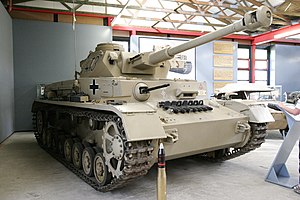Pz IV
| Panzerkampfwagen IV | |
|---|---|

A Panzer IV Ausf G. in desert colors, bearing the palm tree insignia of the 15th Panzer Division of the Afrika Korps
|
|
| Type | Medium tank |
| Place of origin | Nazi Germany |
| Service history | |
| In service | 1939–1945 (Nazi Germany) 1954–1967 (Syria) |
| Used by |
Nazi Germany Romania Turkey Hungary Bulgaria Italy Finland Spain Croatia Syria |
| Wars | World War II, 1948 Arab–Israeli War, Six-Day War |
| Production history | |
| Designer | Krupp |
| Designed | 1936 |
| Manufacturer | Krupp, Vomag, Nibelungenwerk |
| Unit cost | ≈103,462 Reichsmark |
| Produced | 1936–1945 |
| No. built | ≈8,553 of all variants |
| Variants | StuG IV, Jagdpanzer IV, Wirbelwind, Brummbär, Nashorn |
| Specifications (Pz IV Ausf H, 1943) | |
| Weight | 25.0 tonnes (27.6 short tons; 24.6 long tons) |
| Length | 5.92 metres (19 ft 5 in) 7.02 metres (23 ft 0 in) gun forward |
| Width | 2.88 m (9 ft 5 in) |
| Height | 2.68 m (8 ft 10 in) |
| Crew | 5 (commander, gunner, loader, driver, radio operator/bow machine-gunner) |
|
|
|
| Armor | Hull front: 80 mm (3.1 in) Hull side (upper and lower): 30 mm (1.2 in) Hull rear (upper and lower): 20 mm (0.79 in) Hull roof and floor: 10 mm (0.39 in) Schürzen: 5 mm (0.20 in) to 8 mm (0.31 in) Turret front: 50 mm (2.0 in) Turret side and rear: 30 mm (1.2 in) Turret roof: 10 mm (0.39 in) |
|
Main
armament |
7.5 cm (2.95 in) KwK 40 L/48 main gun (87 rounds) |
|
Secondary
armament |
2 × 7.92 mm MG 34 machine guns (3,150 rounds) |
| Engine |
Maybach HL 120 TRM 12-cylinder gasoline engine 300 PS (296 hp, 220 kW) |
| Power/weight | 12 PS (8.8 kW) / tonne |
| Transmission | (Synchromesh ZF SSG 77) 6 forward and 1 reverse ratios |
| Suspension | Leaf spring |
| Fuel capacity | 470 l (120 US gal) |
|
Operational
range |
200 km (120 mi) |
| Speed | 38 km/h (24 mph) to 42 km/h (26 mph) max speed, 25 km/h (16 mph) max sustained road speed 16 km/h (9.9 mph) off road |
The Panzerkampfwagen IV (PzKpfw IV), commonly known as the Panzer IV, was a German medium tank developed in the late 1930s and used extensively during the Second World War. Its ordnance inventory designation was Sd.Kfz. 161.
The Panzer IV was the most widely manufactured German tank of the Second World War, with some 8,500 built. The Panzer IV was used as the base for many other fighting vehicles, including the Sturmgeschütz IV assault gun, Jagdpanzer IV tank destroyer, the Wirbelwind self-propelled anti-aircraft gun, and the Brummbär self-propelled gun.
The Panzer IV saw service in all combat theaters involving Germany and was the only German tank to remain in continuous production throughout the war. Upgrades and design modifications, intended to counter new threats, extended its service life. Generally, these involved increasing the Panzer IV's armor protection or upgrading its weapons, although during the last months of the war, with Germany's pressing need for rapid replacement of losses, design changes also included simplifications to speed up the manufacturing process.
The Panzer IV was partially succeeded by the Panther medium tank, which was introduced to counter the Soviet T-34, although the Panzer IV continued as a significant component of German armoured formations to the end of the war. The Panzer IV was the most widely exported tank in German service, with around 300 sold to Finland, Romania, Spain and Bulgaria. After the war, Syria procured Panzer IVs from France and Czechoslovakia, which saw combat in the 1967 Six-Day War. 8,553 Panzer IVs of all versions were built during World War II, with only the StuG III assault-gun/tank destroyer's 10,086 vehicle production run exceeding the Panzer IV's total among Axis armored forces.
...
Wikipedia
